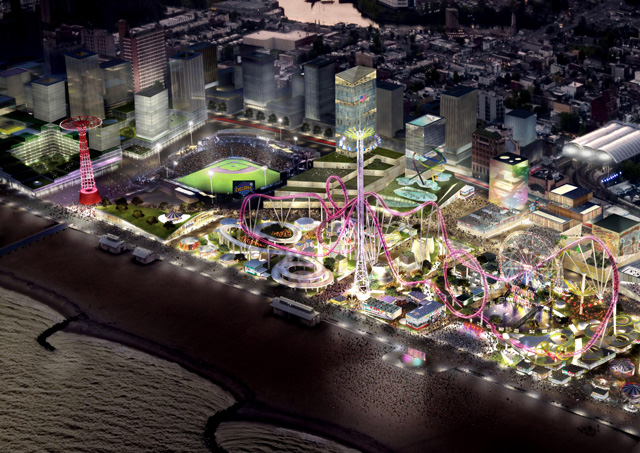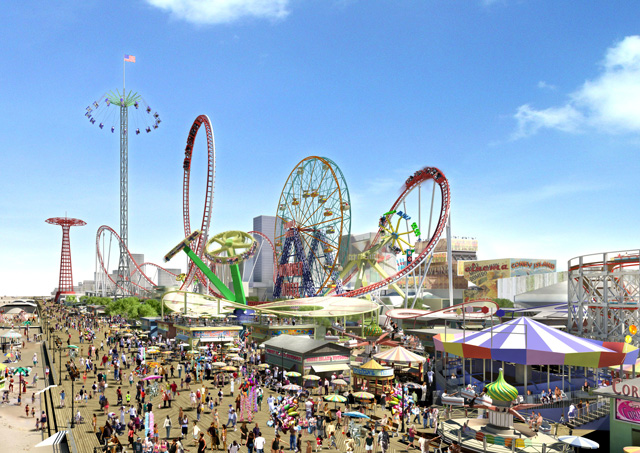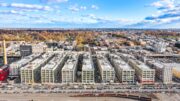When the city approved the Coney Island rezoning in 2009, it seemed that new development would soon transform the character of the beach-fronted peninsula. Along with strengthening the entertainment district, the new plan would allow up to 5,000 residential units and 800 hotel rooms just blocks from the subway, the beach and the Cyclone roller coaster.
Five years after the plan’s conception, none of the proposed 21 residential towers—rising up to 270 feet—seem any closer to being built. Nor are any of the hotels that planners had envisioned along Surf Avenue.
“Sandy put a hold on everything in life down here,” explains Chuck Reichenthal, district manager for Brooklyn’s Community Board 13. “Sandy’s [proven] that more infrastructure work needs to be done.”
Even before Hurricane Sandy pushed over six feet of water onto Surf Avenue, there were doubts about whether Coney Island’s storm-water infrastructure would support the anticipated new residents and businesses.
The Department of Environmental Protection had budgeted approximately $140 million for sewage and stormwater upgrades for the area near Coney’s entertainment district, between West 8th Street and West 21st. According to city documents, the project was initially supposed to begin in the fall of 2012, and completion was anticipated by 2019.
The project has not yet begun. “They were on tap to start new storm-water lines down West 15th Street,” says Reichenthal. “It was supposed to start a few months ago but hasn’t yet.”
It is unclear if these costs have risen dramatically since Hurricane Sandy.
A source at the city’s Independent Budget Office noted that there was $181 million in new capital funding in this year’s budget for unspecified infrastructure at Coney West, or the parcels identified in the 2009 rezoning for the bulk of new residential development. On top of the $140 million already budgeted for stormwater mitigation, the costs of developing Coney Island seem to be rising.
But it is exactly these types of investments—from a previous generation—that saved Coney Island from the worst of Sandy’s storm surge. Many more homes would have been lost if it weren’t for beach reclamation projects carried out by the U.S. Army Corps of Engineers in the mid-1990s. Some portions of the beach were raised by as much as 11 feet.
After Sandy came through, 272,000 cubic yards of sand washed away, leaving the peninsula vulnerable to another super-storm. But the city and federal government worked quickly to restore this essential barrier, and two beach restoration projects have since moved forward. In September 2013 the U.S. Army Corps of Engineers pumped 600,000 cubic yards of sand along the coast of Coney Island. And earlier this month it was announced that new rock jetties would be constructed to prevent further erosion and secure the oceanfront.
However, the biggest threat of future flooding does not come from the ocean, but rather from Coney Island Creek, an inlet that was partially covered over in the early 20th century to provide a direct link with the island (a true island at the time) of Coney.
According to Daniel Zarrilli of the Mayor’s Office of Recovery and Resiliency, during Sandy the creek allowed “floodwaters to reach deep into the neighborhoods of Gravesend and Coney Island, severely impacting vulnerable residents and heavily damaging critical infrastructure.” He added that the creek “could do so again at greater frequency,” and, “even with storms of lesser intensity.”
To address this newly discovered threat, the city’s Economic Development Corporation is heading up a project to mitigate the risk of flooding via Coney Island Creek. The plan is to use “edge-strengthening” and “edge-softening” techniques like the construction of water-absorbing wetlands. Initial plans also include a potential tidal barrier dam and a new levee and tide gate system to prevent the inundation of the peninsula in future storms.
The project is merely in the RFP phase for now, and costs are unknown.
It’s worth remembering that controlling the flow of water on Coney Island will always be a challenge. Historically, Coney Island was made up of a series of creeks, marshes, and barrier islands, all of which have shifted and transformed over the centuries. Is it a losing battle?
Not necessarily. Keep in mind that the modern form of the peninsula is essentially man-made. The fact that it now sustains 102,000 people is a significant achievement of engineering and a testament to the can-do attitude of earlier city-builders.
The peninsula could potentially hold more residents: seven percent of the land is vacant, and the city has planned for 5,000 more residential units. But it seems that the city will need to put forward its investment before the private sector is willing to respond in kind.
For any questions, comments, or feedback, email [email protected]
Subscribe to YIMBY’s daily e-mail
Follow YIMBYgram for real-time photo updates
Like YIMBY on Facebook
Follow YIMBY’s Twitter for the latest in YIMBYnews







